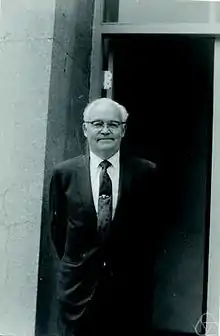Magnus Hestenes | |
|---|---|
 | |
| Born | February 13, 1906 |
| Died | May 31, 1991 (aged 85) Los Angeles, California, US |
| Alma mater | University of Chicago |
| Known for | Augmented Lagrangian method Conjugate gradient method |
| Awards | Guggenheim Fellowship (1954) |
| Scientific career | |
| Fields | Mathematics |
| Institutions | University of California, Los Angeles |
| Doctoral advisor | Gilbert Bliss |
| Doctoral students | |
Magnus Rudolph Hestenes (February 13, 1906 – May 31, 1991) was an American mathematician best known for his contributions to calculus of variations and optimal control.[1] As a pioneer in computer science, he devised the conjugate gradient method, published jointly with Eduard Stiefel.[2][3]
Biography
Born in Bricelyn, Minnesota, Hestenes graduated with a B.S. in 1927 from St. Olaf College and with an M.A. in 1928 from the University of Wisconsin–Madison.[4] He earned his Ph.D. at the University of Chicago in 1932 under Gilbert Bliss. His dissertation was titled "Sufficient Conditions for the General Problem of Mayer with Variable End-Points." After teaching as an associate professor at Chicago, in 1947 he moved to a professorship at UCLA. He continued there until his retirement in 1973, and during that time he served as department chair from 1950 to 1958. While a professor, Hestenes supervised the thesis research of 34 students, among them Glen Culler, Richard Tapia and Jesse Wilkins, Jr.
Hestenes received the Guggenheim (1954) and Fulbright awards, was a vice president of the American Mathematical Society, and was an invited speaker at the 1954 International Congress of Mathematicians in Amsterdam.[5]
He is the father of mathematician and physicist David Hestenes.
He died on May 31, 1991, in Los Angeles, California.
Selected publications
- Hestenes, Magnus Rudolph (1928). Path of a Rotating Sphere. University of Wisconsin–Madison. (M.A. thesis)
- ——— (1966). Calculus of Variations and Optimal Control Theory. Wiley. ISBN 9780471374701.
- ——— (1975). Optimization Theory: The Finite Dimensional Case. Wiley. ISBN 9780471374718.[6]
- ——— (1980). Conjugate Direction Methods in Optimization. Springer. ISBN 9783540904557.
- Landesman, Edward M.; ——— (1992). Linear Algebra for Mathematics, Science, and Engineering. Prentice Hall. ISBN 9780135295618.
References
- ↑ Hestenes, Magnus R. (1966). Calculus of Variations and Optimal Control Theory. New York: John Wiley & Sons.
- ↑ Hestenes, Magnus; Stiefel, E. (1952). "Methods of Conjugate Gradients for Solving Linear Systems" (PDF). Journal of Research of the National Bureau of Standards. 49 (6): 409–438. doi:10.6028/jres.049.044.
- ↑ Hestenes, Magnus (1990). "Conjugacy and Gradients". In Nash, Stephen (ed.). A History of Scientific Computing. New York: ACM Press. pp. 167–179. ISBN 0-201-50814-1.
- ↑ "Magnus R. Hestenes". Computer Pioneers by J. A. N. Lee, IEEE Computer Society.
- ↑ Hestenes, Magnus R. (1954). "Hilbert space methods in variational theory and numerical analysis". In: Proceedings of the International Congress of Mathematicians. Vol. 3. pp. 229–236.
- ↑ Jeroslow, Robert G. (1977). "Book Review: Optimization theory, the finite dimensional case". Bulletin of the American Mathematical Society. 83 (3): 324–336. doi:10.1090/S0002-9904-1977-14252-3.
External links
- Magnus Hestenes at the Mathematics Genealogy Project
- Obituary in the Numerical Analysis Digest
- Magnus Hestenes at Find a Grave